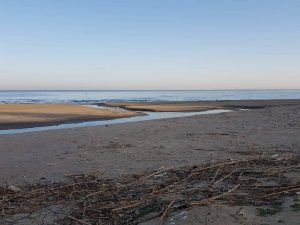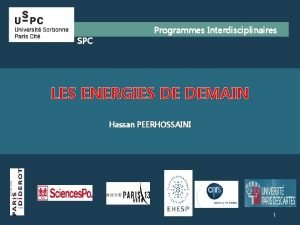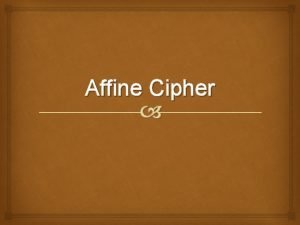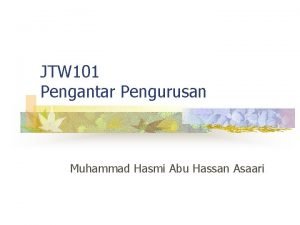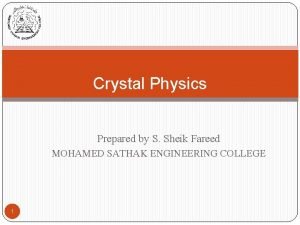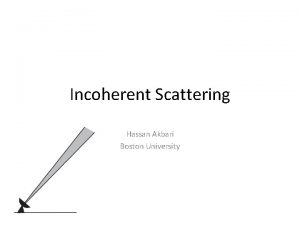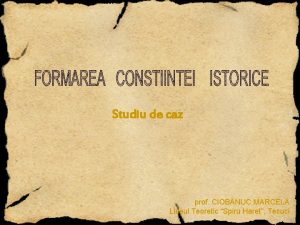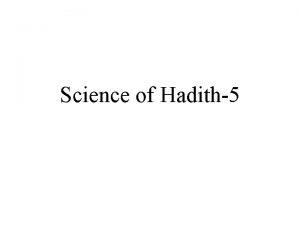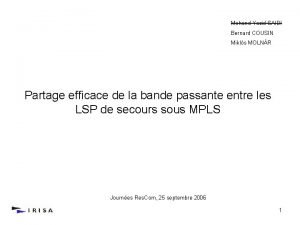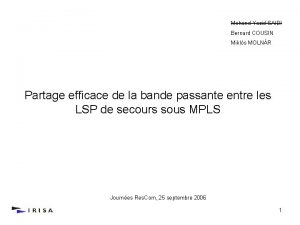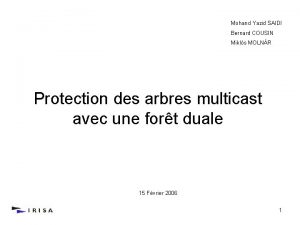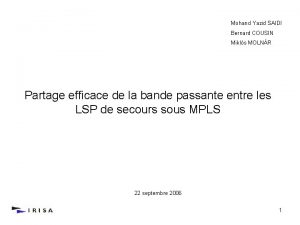Dr Mohand Hassan Moalla 2017 1 Dr Mohand






![Urine concentration n Kidney produce either a concentrated or diluted urine Concentration [m. Osm/L] Urine concentration n Kidney produce either a concentrated or diluted urine Concentration [m. Osm/L]](https://slidetodoc.com/presentation_image_h2/fef63f6787ec7af8c8787c780b085eca/image-7.jpg)



























- Slides: 34

Dr. Mohand Hassan Moalla 2017 1

Dr. Mohand Hassan Moalla 2017 2

Introduction n Kidney has ability for concentration of urine : ü high concentration ü low concentration n according to the body need of water Dr. Mohand Hassan Moalla 2017 3

Introduction Maximal diluted urine 23. 3 Liter/Day If water out of the body need : ü ↓ water reabsorption ü ↓ Urine concentration ü ↑ Urine volume n Dr. Mohand Hassan Moalla 2017 30 m. Osm/L 4

Introduction Maximal concentrated urine q If we need water ü ↑ water reabsorption ü ↑ Urine concentration ü ↓ Urine volume 0. 5 Liter/Day 1400 m. Osm/L Dr. Mohand Hassan Moalla 2017 5

Maximal diluted urine Maximal concentrated urine 23. 3 Liter/Day 0. 5 Liter/Day 30 m. Osm/L 1400 m. Osm/L Dr. Mohand Hassan Moalla 2017 6
![Urine concentration n Kidney produce either a concentrated or diluted urine Concentration m OsmL Urine concentration n Kidney produce either a concentrated or diluted urine Concentration [m. Osm/L]](https://slidetodoc.com/presentation_image_h2/fef63f6787ec7af8c8787c780b085eca/image-7.jpg)
Urine concentration n Kidney produce either a concentrated or diluted urine Concentration [m. Osm/L] Volume [Liter/day] Maximal diluted urine 30 23. 3 Maximal concentrated urine 1400 0. 5 Dr. Mohand Hassan Moalla 2017 7

Urine concentration (water reabsorption ) osmotic gradient ADH Dr. Mohand Hassan Moalla 2017 8

ADH osmotic gradient Dr. Mohand Hassan Moalla 2017 9

cortex 300 m. Osm/L H 2 O corticopapillary osmotic gradient H 2 O 1200 m. Osm/L papilla urea recycling H 2 O countercurrent system Dr. Mohand Hassan Moalla 2017 10

Urine concentration n Urine concentration is operated by water reabsorption n Water reabsorption requires ADH and osmotic gradient “corticopapillary osmotic gradient” n The major factors that contribute to the buildup this osmotic gradient into the renal medulla are as follows: 1. countercurrent system 2. urea recycling Dr. Mohand Hassan Moalla 2017 11

corticopapillary osmotic gradient it is a gradient of osmolarity in the interstitial fluid of the kidney from the cortex to the papilla n The osmolarity of the cortex is approximately 300 m. Osm/L n The osmolarity of the papilla is approximately 1200 m. Osm/L n Dr. Mohand Hassan Moalla 2017 12

countercurrent system inflow outflow This occurs in: Ø loops of Henle Ø vasa recta q parallel n counter [opposite direction] n close proximity n Dr. Mohand Hassan Moalla 2017 13

countercurrent system n The concentrating mechanism depends upon the maintenance of a gradient of increasing osmolality along the medullary pyramids concentrating mechanism countercurrent exchangers countercurrent multipliers Dr. Mohand Hassan Moalla 2017 14

countercurrent multipliers Loop of Henle Dr. Mohand Hassan Moalla 2017 15

interstitial fluid Thick ascending loop of Henle 300 300 300 Dr. Mohand Hassan Moalla 2017 16

interstitial fluid 300 300 400 200 H 2 O 300 400 200 Dr. Mohand Hassan Moalla 2017 17

interstitial fluid 300 400 400 200 Dr. Mohand Hassan Moalla 2017 18

interstitial fluid 300 400 200 400 400 400 Dr. Mohand Hassan Moalla 2017 19

interstitial fluid 300 H 2 O 350 150 400 H 2 O 500 300 H 2 O 400 500 300 Dr. Mohand Hassan Moalla 2017 20

interstitial fluid 300 350 350 150 500 500 300 Dr. Mohand Hassan Moalla 2017 21

interstitial fluid 300 350 500 500 Dr. Mohand Hassan Moalla 2017 22

interstitial fluid 300 425 225 350 600 400 Dr. Mohand Hassan Moalla 2017 23

interstitial fluid 300 425 425 225 600 600 650 400 Dr. Mohand Hassan Moalla 2017 24

countercurrent multipliers Single effect (First step) flow of tubular fluid (second step) Na. Cl is reabsorbed 1. inflow of tubular in the thick fluid from the ascending limb proximal tubule 2. Water is reabsorbed 2. outflow of tubular in the descending fluid into the distal limb tubule. 1. Dr. Mohand Hassan Moalla 2017 25

single effect n n n Na. Cl is reabsorbed via the Na+-K+-2 Clcotransporter out of the ascending limb Na. Cl is deposited in the surrounding interstitial fluid osmolarity increases to 400 m. Osm/L the fluid in the ascending limb is diluted to 200 m. Osm/L. Fluid in the descending limb equilibrates with the interstitial fluid, and its osmolarity also becomes 400 m. Osm/L. Dr. Mohand Hassan Moalla 2017 26

flow of fluid n New fluid with an osmolarity of 300 m. Osm/L enters the descending limb from the proximal tubule n Equal volume of fluid is displaced from the ascending limb n High osmolarity fluid in the descending limb (400 m. Osm/L) is "pushed down" toward the bend [apex] of the loop of Henle. Dr. Mohand Hassan Moalla 2017 27

countercurrent multipliers n These two basic steps are repeated until the full corticopapillary gradient is established n each repeat of the two steps increases, or multiplies, the gradient. n The size of the corticopapillary osmotic gradient depends on the length of the loop of Henle. n In humans, the osmolarity of interstitial fluid at the bend of the loop of Henle is 1200 m. Osm/L Dr. Mohand Hassan Moalla 2017 28

countercurrent exchange n vasa recta operate as countercurrent exchanger n countercurrent exchange differs from countercurrent multiplication as follows: countercurrent multiplication active process establishes the osmotic gradient countercurrent exchange passive process maintain the osmotic gradient Dr. Mohand Hassan Moalla 2017 29

countercurrent exchange n vasa recta are capillaries n vasa recta consisted of: - The descending limb (where Blood entering ) 2. The ascending limb (where Blood exit ) n Purpose: n Maintaining of osmotic gradient by keeping solute (Na+, urea) in pyramid from losing by the circulation 1. Dr. Mohand Hassan Moalla 2017 30

300 300 H 2 O Cortical Na. CL & urea 600 600 H 2 O Na. CL & urea Outer medulla 1200 H 2 O Na. CL & urea Dr. Mohand Hassan Moalla 2017 inner medulla 31

Urea Recycling 50% Cortical ADH outer Urea inner UT-A Dr. Mohand Hassan Moalla 2017 32 10%

Urea Recycling n n n Urea contributes to the establishment of the osmotic gradient in the medullary pyramids ability to form a concentrated urine in the collecting ducts. Urea transport is mediated by urea transporters (UT-A) Urea is produced as result of protein catabolism high-protein diet increases the ability of the kidneys to concentrate the urine. Dr. Mohand Hassan Moalla 2017 33

Dr. Mohand Hassan Moalla 2017 34
 Akli mohand oulhadj bouira
Akli mohand oulhadj bouira Mohand al shehri
Mohand al shehri Snv bouira
Snv bouira Dr mohand
Dr mohand Hassan peerhossaini
Hassan peerhossaini Hassan bassidi
Hassan bassidi Hassan makki
Hassan makki Dr mona idris
Dr mona idris Hassan javaid
Hassan javaid Fatima el hassan
Fatima el hassan Université hassan 2 mohammedia
Université hassan 2 mohammedia Hassan squalli
Hassan squalli Syed afaq hassan solicitor
Syed afaq hassan solicitor Hassan kite runner
Hassan kite runner Bnx eye drops
Bnx eye drops Hassan chafi
Hassan chafi Ksheera convention hall hassan
Ksheera convention hall hassan Hassan sayyadi
Hassan sayyadi Muhammad hasmi abu hassan asaari
Muhammad hasmi abu hassan asaari Point defects in crystals
Point defects in crystals Hassan mokhlis
Hassan mokhlis Hassan akbari
Hassan akbari Comparati baladele pasa hassan
Comparati baladele pasa hassan Juxtra glomerular apparatus
Juxtra glomerular apparatus Caracterizarea lui pasa hassan
Caracterizarea lui pasa hassan Khaled hosseini hassan
Khaled hosseini hassan Junaid hassan
Junaid hassan Dr uzma hassan
Dr uzma hassan Hassan takabi
Hassan takabi Hassan ben moussa
Hassan ben moussa Mahmood ul hassan islamic aid
Mahmood ul hassan islamic aid Anhar hassan
Anhar hassan Dr hassan abdalla
Dr hassan abdalla Dr nada hassan syed
Dr nada hassan syed Hassan tout
Hassan tout


